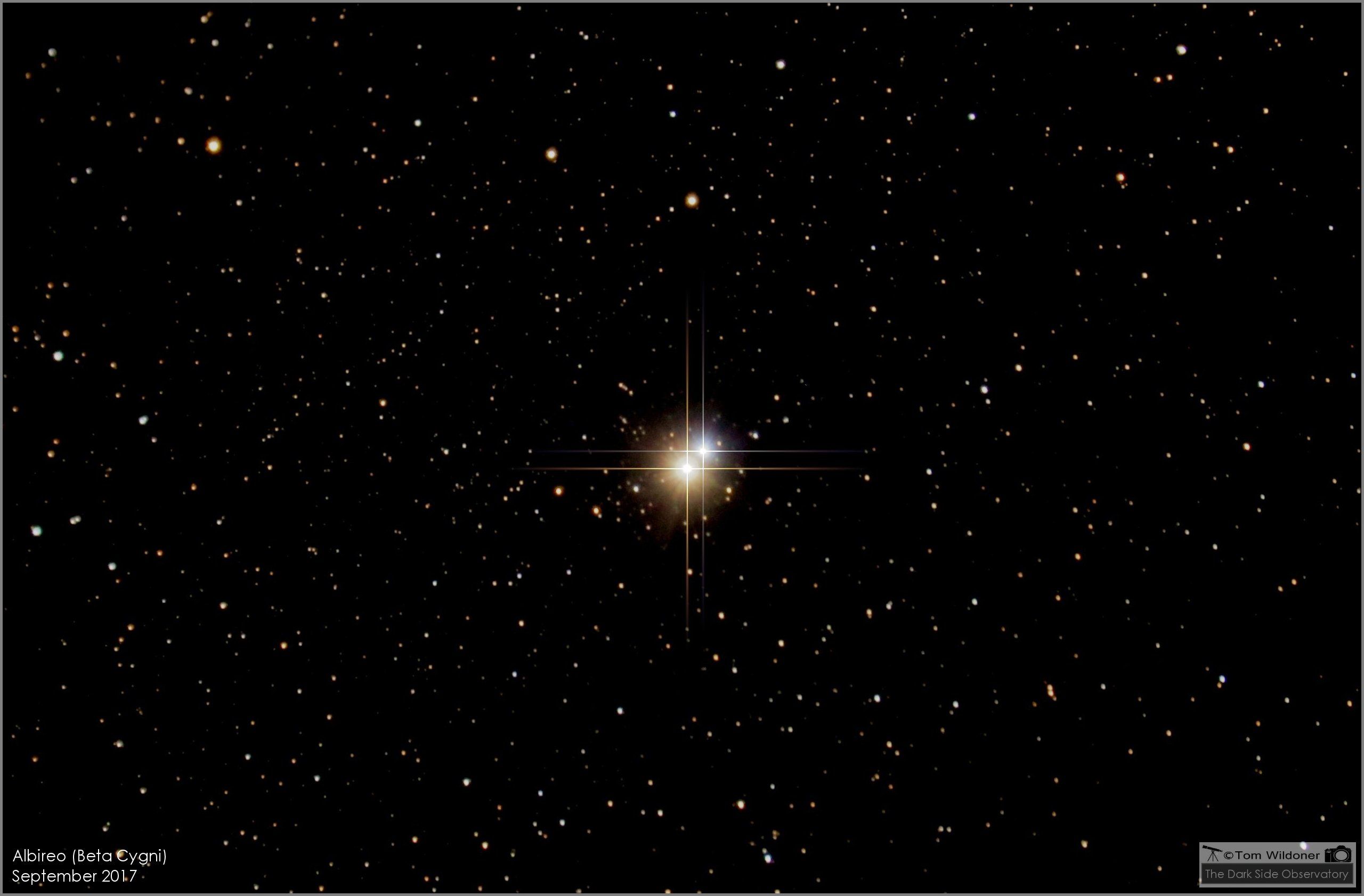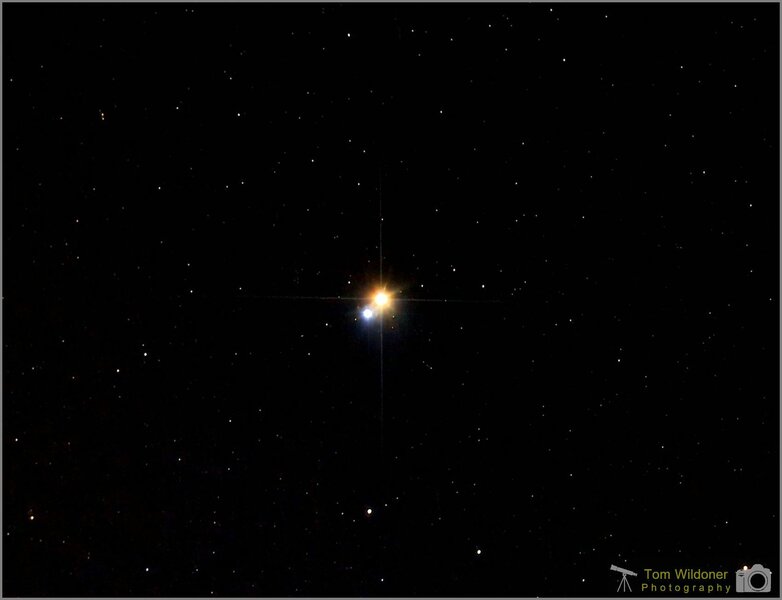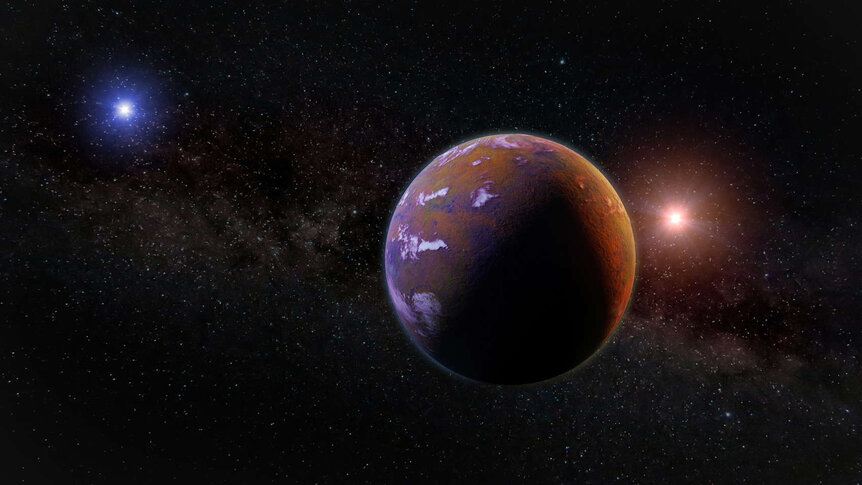Create a free profile to get unlimited access to exclusive videos, sweepstakes, and more!
Just how many stars *is* Albireo, and is one of them a black hole?

The star Albireo is a favorite among amateur astronomers. Easily visible to the naked eye in northern hemisphere summer, it marks the head of Cygnus the Swan (or the base of the Northern Cross; you picks your asterisms and you takes your chances).
The magic happens when you look at it through a small telescope. It's easily resolved into two stars: A bright one that shines orange-red (called Albireo A), and a slightly dimmer one (Albireo B) that is sapphire blue.
It was an open question for centuries whether this was indeed a true binary star — two stars orbiting one another, bound by gravity — or if it's a coincidence, with them being at different distances from us but we happen to see them near each other in the sky.
In 2018 I wrote that finally, this issue was solved: The Gaia satellite had measured their distances and motions across the sky. The distances appeared to be quite different, though the statistical significance of that was debatable (the brighter star is hard for Gaia to get good numbers for). Moreover, the motions of the two stars through space (called the proper motion) appeared to be different. Case closed! They're a coincidental double.
… except maybe not so much. This turns out to be a more subtle and difficult thing to measure than I first thought.
I tweeted about using Gaia to solve the problem in 2018, and astronomer Ron Drimmel, who works with Gaia, answered that call. However after further thought and research, he realized there were a number of issues with our first conclusion of the two stars being distinct. It also turns out that the every few years there's a new release of Gaia data, with updates reflecting the current understanding of the observatory and its issues. Not long after I wrote my own article there was another data release, and things have changed.
For one thing, the distances measured by Gaia were very uncertain at first, but in this new release the errors are much smaller. It turns out the distances it measures for the two stars aren't as disparate as first thought. They're still pretty far apart — in real terms, probably 30–60 light years, means they are still unlikely to be a binary, but maybe close enough to be associated with one another.
Measuring their motions across the sky is more difficult than first thought as well. The red giant, Albireo A, is itself a true binary, with a very close companion star that is very difficult to see. But that means they orbit around each other as well as move across the sky. If you don't account for this orbital motion you may get the wrong proper motion!
So Drimmel, along with a team of astronomers, dug into the data to see what's what. They looked at quite a bit of older data from other observatories (extending the baseline of observations over many years makes motions less uncertain), including some from over a century ago! They also examined spectra taken of the stars to see if that would help determine characteristics like the star masses, brightness, and ages. Those in turn inform about the star behaviors.
What they found is pretty amazing. The brighter star, Albireo A, is in fact a binary, with a red giant (called Albireo Aa), in orbit with a blue main sequence star, one still fusing hydrogen into helium in its core (called Albireo Ac; the letter b was skipped so it wouldn't be confused with Albireo B, the other star seen in small telescopes).
The spectra show that the red giant Aa has a mass of roughly 5.2 times the Sun, and the blue star Ac about 2.7. In general, stars age faster if they have a higher mass, so you'd think the red giant would be more massive than the blue one. They also find the third star, Albireo B, has a mass of 3.7 times the Sun's.
OK. Then they looked at measurements of the stars' positions, trying to see if they can detect enough orbital motion to calculate the orbital shape. That also yields the star masses. The two stars Aa and Ac revolve around each other in a mildly elliptical orbit that takes 120 years, and they have an average distance of about 7 billion kilometers from each other.
Great! But then things get weird. The orbit depends on the star masses, and what they get from that is that the red giant has a mass of about 4 times the Sun, and the blue companion about 5.
Um. That's opposite of what the spectra say. Aa should be more massive than Ac. What gives?
They think the orbital measurement is likely to be more accurate. Going through the detailed math, they think what this means is that there's more mass in the Albireo A system, but it's hidden.
How do you hide mass? Well, for example, Albireo Ac might itself be a binary star! If they orbit very close together they'd appear as one star, and would also explain why the spectra mischaracterized it. The problem here is if that's true you wind up getting unreasonable numbers for other parts of the system. So it seems unlikely.
Another way to have a massive but dark object is if it's a black hole. That would actually fit the observations pretty well, but no direct evidence for a black hole is seen — like, say, a lot of X-rays blasting out if it's eating material. On the other hand not all black holes are actively feeding, so it may just be quiescent. I'd say a black hole is unlikely, but can't be ruled out yet.
So it's not hugely clear what's going on here in detail. They were able to come up with a fun thing, though: Even if they aren't bound together as a wide binary, Albiero A and B (the two easily seen in a 'scope) are still suspiciously close together in our sky as well as in actual space. And their motions are not as different as once thought.
This could mean that although they're not a binary, they may have formed in the same gas cloud and are moving through space together! In fact, looking through Gaia data, Drimmel and his team found four other stars near them with similar motion. This could be a small association of stars that all formed together and still move through space near each other.
What a mess! First we thought they were together, then maybe they weren't, then maybe they aren't together together (in a binary system) but still traveling together. And instead of it being two stars, Albireo is at least three stars (Albireo Aa, Ac, and B) and may even be four (Aca and Acb, I think; notation gets complicated here). And one of those might be a black hole!
Oof. Well, no one ever said this had to be simple. At least I'll have a lot to think about when I look at Albireo through my telescope later this summer. And, like most science stories, it's not over yet. There's still quite a bit to figure out here. Hopefully we'll eventually have a better understanding, because honestly, this is already a lot.





























